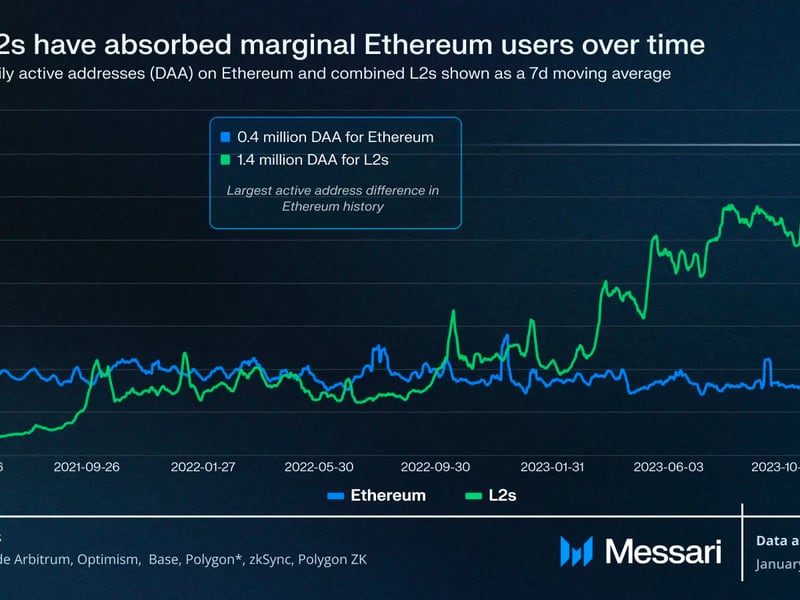The Protocol: Bitcoin’s OP_CAT, Fake Ethereum Tokens, Starknet’s Airdrop
Air Drop #AirDrop

We love to write about blockchain tech, and we hope you love The Protocol newsletter. Not sure how else to say this but: We ♥️ our readers.
In this week’s issue:
This article is featured in the latest issue of The Protocol, our weekly newsletter exploring the tech behind crypto, one block at a time. Sign up here to get it in your inbox every Wednesday. Also please check out our weekly The Protocol podcast.
Network news
FILES NOT FOUND: Ethereum has a standardized process for adding new token standards, including the well-known ERC-20, for fungible tokens, and ERC-721, for non-fungible tokens or NFTs. But a new unofficial token standard, ERC-404 is suddenly getting traction – and there’s now a supposedly improved version called DN-404. Both standards aim to combine virtues of fungible and non-fungible tokens, theoretically offering the potential to fractionalize NFTs – sort of like creating separate tokens representing a partial interest. The first ERC-404 token, PANDORA, traded as high as $32,000 on Friday morning from a low of $250, in just under a week, as reported by CoinDesk’s Shaurya Malwa. “Several projects have already latched on to the hype and issued their own versions of ERC-404 tokens,” including on the Arbitrum and Solana blockchain ecosystems, Malwa wrote. According to the analysis firm FundStrat, “this standard also seamlessly aligns with the ongoing trend of meme token trading.” Nansen, the blockchain data firm, noted in an email that PANDORA “recorded a staggering $190 million in trading volume just a week after it was launched.” The flurry was enough to drive a spike in Ethereum fees. Wu Blockchain newsletter wrote that “the current hype and FOMO are already very strong.” CoinDesk’s Daniel Kuhn wrote that there are nagging worries some blockchain users might mistakenly think that ERC-404s have been approved and vetted under the official process – raising “concerns over the safety of the technical design of ERC-404s, considering that they are unaudited.” On Monday, a group of Ethereum application developers started a new unofficial token contract purporting to solve some of the apparent drawbacks – called DN-404, short for “Divisible NFT-404.” One of the developers, who goes by the X handle @0xQuit, tweeted that the newer version “averages about 20% gas savings vs ERC-404.”
AIRDROP SEASON: Starknet Foundation, supporting the Ethereum layer-2 blockchain Starknet, announced plans for the much-awaited airdrop of STRK tokens next week, on Feb. 20. (As of early Wednesday, traders on the decentralized exchange Aevo’s pre-launch futures were already suggesting that the project’s market capitalization might exceed $1 billion when it goes live on Feb. 20.) Separately, the cross-chain protocol Wormhole announced a planned airdrop for its new W token, including 12% of the tokens for core contributors and 31% for “ecosystem and incubation,” which includes growth initiatives for the project’s developer community.
ALSO:
Protocol Village
Top picks of the past week from our Protocol Village column, highlighting key blockchain tech upgrades and news.

Schematic of Polygon’s “Type 1 Prover” (Polygon)
See the entire Protocol Village list from this past week here.
Satoshi-Era Bitcoin Function ‘OP_CAT’ Dusted Off as Development Fervor Grows
Armin Sabouri (left), one of the co-authors of the OP_CAT proposal; with Dan Gould, a Bitcoin developer; and co-author Ethan Heilman, in October at Chaincode Labs’ Bitcoin Research Day, in New York. (Neha Narula)
As Bitcoin developers experiment with features and upgrades that increasingly resemble the vibrant activity on alternative blockchains like Ethereum, some of programmers are pushing for a revival of a piece of code that existed on the network in its early days.
A Bitcoin improvement proposal (BIP) for a new version of the “OP_CAT” code, introduced in October, aims to restore functionality that was available in early versions of the blockchain’s software but was removed by its elusive and likely pseudonymous creator, Satoshi Nakamoto, in 2010.
The developers behind the proposal, Ethan Heilman and Botanix Labs’ Armin Sabouri, describe OP_CAT as a simple opcode – just a dozen or so lines of code – that could provide the general-purpose functionality that’s been missing from Bitcoin since its very early days, and that’s seen as a key driver of growth on Ethereum, the second-biggest blockchain. So-called layer-2 networks might be easier to build atop Bitcoin, along with other innovations like decentralized exchanges or file hosting.
“My biggest use case for CAT is introducing protocols that have the ability to post something on the layer 1 and have another transaction reference it, showing that one element proves another element and so on,” Sabouri told CoinDesk.
Read the full story by Jamie Crawley here
Money Center
Fundraisings
Deals and Grants
Data and Tokens
Ethereum Validator Entry Queue Signals Renewed Interest in Staking
The Ethereum network is witnessing a spike in the number of validators looking to stake their ether (ETH), CoinDesk’s Omkar Godbole reports. The so-called validator entry queue has jumped to 7,045, the highest since Oct. 6, according to data source ValidatorQueue. “Resurgence in Ethereum staking activity indicates initial signs of renewed vitality,” David Lawant, head of research at institutional crypto exchange FalconX, wrote in an email. While the number of stakers looking to join the network has spiked, the tally remains well below the figures over 75,000 seen following Ethereum’s Shapella upgrade in April last year.
Calendar
This story originally appeared on Coindesk